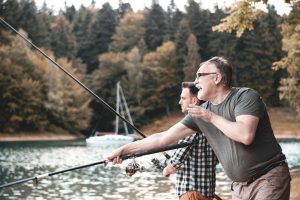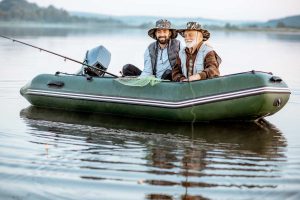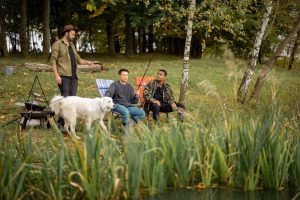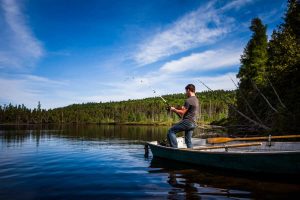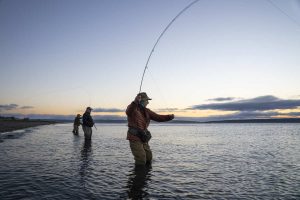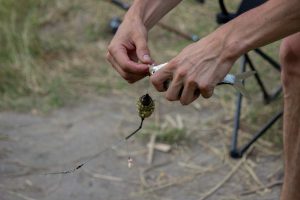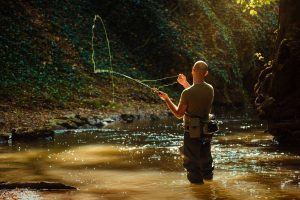Fishing is a great hobby for all ages, as it offers a chance to enjoy the beauty of nature while also engaging in an interesting and challenging activity. It can be enjoyed alone or with friends and family, offering something for everyone no matter their skill level. Whether you’re an experienced angler or just starting out, fishing provides a unique experience that can’t be found elsewhere.
For those just getting into fishing, there are plenty of destinations around the world that offer great opportunities for both saltwater and freshwater trips. From the Florida Keys to Chesapeake Bay and from Galveston to Montauk Point State Park, there is sure to be somewhere perfect for your next adventure! Additionally, spots like San Diego Pier or Virgin Islands National Park provide tranquil waters where beginners can practice without feeling intimidated by more experienced fishermen nearby.
Best Saltwater Fishing for Beginners
The thrill of a catch is something that all fishermen can relate to. Whether you’re an experienced angler or just starting out, there are plenty of great locations for saltwater and freshwater fishing around the world. From Florida Keys to Chesapeake Bay and from Galveston to Montauk Point State Park, each destination offers its own unique experience and variety of fish species. In this section we will explore some of these destinations in more depth, looking at what kind of fish can be caught in each spot as well as important tips on where to find them and other things you should know before heading out!
The Florida Keys
The Florida Keys is one of the most popular saltwater fishing destinations in the world, with a variety of fish species to be caught including snapper, grouper, barracuda, and more. It’s known for its beautiful waters and great visibility that make it perfect for any level angler.
To get the best experience out of your trip here you should plan ahead by researching where to find certain types of fish as well as what kind of bait they prefer. Additionally, knowing your local regulations before heading out is important so you don’t end up breaking any laws or getting fined!
What Is the Fishing Like?
The Florida Keys is home to a variety of saltwater fish species, including snapper, grouper, barracuda, cobia, tarpon and more. Additionally, there are plenty of smaller species such as snook, redfish and flounder that can be found in the shallow waters.
The Florida Keys offers a variety of environments from shallow flats and mangrove shorelines to deeper reefs and wrecks, which makes it perfect for any type of fishing you want to do. Depending on what kind of fish you’re looking for, your best bet is researching ahead of time where they’re most likely to be located in the area so that you can maximize your chances of finding them during your trip!
Some Additional Tips
The Florida Keys is home to a variety of protected species, so it’s important that you understand the local regulations and restrictions before heading out on your trip.
Additionally, it is important to get an understanding of the regulations related to size limits, catch-and-release policies and season restrictions as these vary depending on where you are fishing. Knowing tide patterns can also help maximize success while out on the water.
Lastly, familiarizing yourself with local marine life such as alligators or manatees will ensure anglers have a safe and enjoyable experience while fishing in The Florida Keys!
Here are a few online resources to check out before your trip:
- Florida Fish and Wildlife Conservation Commission: This website provides information about fishing regulations, licenses, and catch limits for the Florida Keys.
- Key Largo National Marine Sanctuary: This site offers an interactive map of marine reserves in the area, as well as access to educational materials related to responsible boating and fishing practices.
- VisitTheFloridaKeys.com: A comprehensive guide for planning a trip to The Florida Keys with detailed information on lodging options, activities, attractions, and more!
- FishingBooker: Reviews from experienced anglers who have gone out on charter boats or fished independently in The Florida Keys can be found here along with ratings of local guides and services that specialize in sportfishing trips in the area
Chesapeake Bay
Chesapeake Bay is another popular saltwater fishing destination, offering a variety of species such as striped bass, bluefish, drum and more. It’s known for its calm waters and easy access to all sorts of different habitats, making it perfect for both novice and experienced anglers alike.
To maximize your chances of catching fish here you should research ahead of time where certain types are most likely to be found in the area along with what kind of bait they prefer! Additionally, make sure that you understand the local regulations before heading out so that you don’t end up getting fined or breaking any laws!
What Is the Fishing Like?
Chesapeake Bay is home to a variety of saltwater species, including striped bass, bluefish, croaker, and drum. Additionally, there are plenty of smaller species such as spot and perch that can be found in the shallow waters around the bay area.
Depending on what type of fish you’re looking for, your best bet is researching ahead of time where they’re most likely to be located in the area so that you can maximize your chances during your trip! The bay offers a variety of habitats from open water areas to deeper channels and rocky shorelines which provide plenty of options when it comes to finding where certain types of fish will be hiding out!
Some Additional Tips
When fishing in the Chesapeake Bay, there are often a variety of techniques and methods that anglers can use. It is important to research what type of fish you are looking for, as well as the best way to target them. Additionally, it is important to be aware of local regulations when fishing in the bay and make sure all equipment used is up-to-date and safe.
Certain areas may require special permits or licenses depending on where you are located. Bait selection should also be taken into account when fishing in the bay; live bait such as worms or clams will usually yield better results than artificial lures. Finally, anglers should always practice catch and release whenever possible – not only does this help preserve resources but it also helps ensure future generations will have equal access to these great recreational opportunities!
There are a variety of online resources that can help anglers better understand the Chesapeake Bay. The Maryland Department of Natural Resources offers information on fishing regulations and best practices, as well as tips for targeting different species. The National Oceanic and Atmospheric Administration also provides detailed maps of the bay’s topography and water temperature.
Additionally, many local tackle shops offer website with useful resources for anglers such as reports from experienced fishermen about recent catches or recommendations for bait selection in specific areas. Finally, there are numerous blogs written by avid fisherman which provide helpful insight into successful methods used in the bay.
Galveston, TX
Galveston, TX is another great saltwater fishing destination with a variety of species such as redfish, trout, flounder and more. It has easy access to both the Gulf of Mexico and the Intracoastal Waterway which means that you’ll be able to find plenty of different habitats while out on your trip.
To maximize your chances here, you should research ahead of time where certain types are most likely to be found in the area along with what kind of bait they prefer! Additionally, make sure that you understand local regulations before heading out so that you don’t end up getting fined or breaking any laws!
What’s the Fishing Like?
Galveston offers a variety of saltwater species such as redfish, trout, flounder and more. Additionally, there are plenty of smaller species like croaker, spot and sheepshead that can be found in the shallow waters around the area.
There is plenty of variety in terms of habitat around Galveston, with both open water areas and shallow bayous providing a range of options when it comes to finding the right spot for your fishing excursion! Depending on what type of fish you’re looking for, researching ahead where they’re most likely to be located can help maximize your chances during your trip!
Some Additional Tips
Make sure that you understand all local regulations before heading out on your trip as there may be specific restrictions or fines associated with catching certain species or using particular baits or techniques while fishing in Galveston, TX!
It is important to obtain a valid fishing license before heading out on the water in Galveston. Licenses can be purchased online or at various tackle shops and bait stands around town.
Here are some resources for fishing in Galveston:
- Texas Parks and Wildlife Department – The TPWD provides fishing regulations, license information, fish stocking data and more.
- Galveston Fishing Forum – This online forum is a great resource for finding out what other anglers are doing when they’re fishing in Galveston.
- Texas Saltwater Fishing Magazine – This magazine offers up-to-date reports on the best spots to fish in Galveston as well as tips and tricks from local experts that you won’t find anywhere else.
- SeaWolf Park Fishing Pier – If you’re looking for a good spot to cast your line while visiting or living in Galveston, this pier offers easy access to some of the most productive waters around town!
- VisitGalveston – Here you can find all sorts of helpful information about fishing charters and guides available throughout the area so you can have an even better experience when it comes time to hit the water!
Montauk Point State Park
Montauk Point State Park is one of the premier saltwater fishing spots on the East Coast, with a variety of species such as stripers, fluke and sea bass available to be caught here. Its rocky shoreline provides plenty of areas where fish can hide out in the shadows while its strong currents make it perfect for those looking to catch large game like tuna or marlin!
Montauk Point State Park is a great destination for anglers of all ages and abilities, offering world-class saltwater fishing opportunities in its sheltered coves, brilliant reefs, jetties along the shoreline. Here you have potential to land anything from striped bass to false albacore with just your rod and reel!
Plus, there are plenty of charter boat operators ready to take you into areas otherwise inaccessible by foot or kayak. Whether it’s bringing home dinner at the end of an enjoyable day on the water or discovering something new about yourself that never would’ve known unless were out here – Montauk will surely deliver some unforgettable experiences as well as good catches when done right.
What’s the Fishing Like?
Montauk Point State Park is home to a variety of highly sought-after species such as false albacore, striped bass, black sea bass and bluefish. Some anglers are even lucky enough to reel in porbeagle sharks or mako shark on occasion!
There have been documented accounts from captains successful onto finding mackerel here too. With clear skies year-round allowing for an abundance of marine life it’s no wonder why saltwater fishing at Montauk has become so popular over the years.
For anglers looking for a unique and isolated experience, heading offshore from Montauk Point State Park is sure to be rewarding. The deep waters of Block Island Sound provide false albacore and striped bass with plenty of hiding spaces as well as open ocean conditions perfect for catching mako sharks or porbeagle sharks if your luck has it!
Taking out kayak rentals along local coves can yield good results too including fluke (summer-flounder) which loves these protected habitats full of sand eels and squid. Jetty fishing around the points outside Fort Pond Bay might also lead you onto other great catches such bluefish while drifting shift through mussel beds in Sachem’s Head Harbor provides some incredible action on beautiful black sea bass when done correctly.
Some Additional Tips
When looking at planning a trip out to fish in Montauk, there’s only really one thing you need: A proper license. Having the right credentials not allows anglers access to more productive waters otherwise inaccessible by foot or kayak but also gets them covered for any catches taken during their time on-site as well. Be sure to check all local regulations prior departing – those found violating these laws can face steep fines and possible jail times depending upon circumstance so it’s best practice always (as with anywhere) play fair!
Additionally, if seeking professional help from hired guides that offer charters it’s advisable make reservations ahead of time; prime dates fill up quickly throughout season due months advance sometimes!
When planning a trip to the Montauk Point State Park, there are several online resources that can be checked out prior to departing:
The official website of Montauk Point State Park provides helpful information on park regulations, fishing licenses and seasonal restrictions. For further insight into the area’s aquatic life, visitors can check out the National Oceanic and Atmospheric Administration (NOAA) website for data on fish stocks in local waters.
Additionally, anglers may find useful tips and advice on nearby charter boat captains by checking out websites such as FishingBooker. Finally, individuals looking for more general information about what to expect during their visit should consult travel guides such as Lonely Planet or Fodor’s Travel Guides for an overview of activities available at Montauk Point State Park.
San Diego Pier
The San Diego pier offers exciting saltwater fishing opportunities to anglers of all ages. Located off the picturesque downtown waterfront, with beautiful views across to nearby Coronado Island and over two thousand feet out towards SeaWorld its easy see why so many beach-goers make their way here every year for some serious shoreline fun!
A wide range of species can be found lurking in the varied habitats around these longer piers which leads onto a great variety possible catch from trolling calico bass near jetty rocks drifting surf perch kelp beds seeking white seabass amongst wreckage far offshore – something everyone will enjoy no matter what level experience they bring!
What’s the Fishing like?
At the pier, anglers will have a good chance to land calico bass throughout any season – one top catches here fitting right into bag limits and perfect for eating as well. Sand crabs are also present (though rare) so time might be better spent targeting bat rays or queenfish near jetty rocks during periods higher water clarity rather than going after these molluscs however bottom fishing around South float could hold nicely sized halibut if conditions deem unacceptable elsewhere else!
Trolling local bait schools within piers deeper regions yields some sizeable white-sea bass and barracuda too when done properly, potentially jacks even spotted mackerel shallower waters guys like me must try least once life.
The best places to catch fish at the San Diego pier are near jetty rocks and around deeper areas of the pier. Calico bass can be found in shallow waters, usually between 10-40 feet of depth, while trolling for white sea bass and barracuda is best done further out where depths exceed 60 feet.
Bottom fishing near South float may yield halibut when conditions are right, but jacks and spotted mackerel can also be caught along shallower waters closer to shoreline.
Some Additional Tips
The most important thing that anglers need to know before heading out on a day trip from the San Diego Pier is what species they’re hoping to target as well as local regulations set forth by state authorities regarding size/bag limits associated with them.
Many locations have imposed strict rules on certain types of catches, so it pays (literally) do research ahead time ensure nothing illegal taken home end day – even unintentional!
Additionally, its highly recommended bring appropriate gear depending upon targeted species type – live bait rigs needed bottom fishing example while trolling requires stronger rods reels capable handling heavier loads, if necessary, chase down larger game offshore!
There are several online resources to check out before your trip:
- San Diego Bay Fishing
- Pier Fishing in California
- Mission Bay Aquatic Center
- Visit San Diego: Fishing Charters & Tours
Virgin Islands National Park
The Virgin Islands National Park is a paradise for fishermen offering the unique opportunity to fish in both the Caribbean Sea and Atlantic Ocean. With crystal clear waters, plentiful marine life and miles of gorgeous shoreline there are plenty of opportunities to catch some incredible species here ranging from snapper and grouper to tarpon, wahoo and even mahi-mahi.
There’s something for every level of angler whether you’re just starting out or have been fishing these waters your whole life – no doubt it’ll be an unforgettable experience sure bring back some good stories over the dinner table!
What’s the Fishing Like?
The Virgin Islands National Park offers an abundance of different types of fish that any angler can target depending on their skill level. Popular catches here include snappers like yellowtail, mutton and cubera; groupers such as black, red hinds and Nassau; barracuda; kingfish; mahimahi (dolphin); wahoo; tarpon as well other reef dwelling creatures like triggerfish grunts or squirrelfish which all make great eating too!
In addition, offshore deep-sea fishing trips offer potential onto encountering large pelagic species including marlin sailfish potentially even giant bluefin tuna if conditions right day/time based upon current weather patterns water temperatures!
The best places to catch fish at Virgin Islands National Park depend on what type of species anglers are looking for. For inshore fishing, spots along the shoreline and within coves provide excellent opportunities to land snappers, groupers and barracuda while trolling around reefs with live bait can yield wahoo, mahimahi and kingfish if done properly.
Offshore trips offer chances at larger game like marlin or sailfish depending upon conditions – booking a charter boat required taking out such deep-sea excursions however still plenty potential onto having great time closer home waters too!
Some Additional Tips
- Make sure you have a valid fishing license from the Virgin Islands Department of Planning and Natural Resources (DPNR).
- Understand the regulations in place for fishing, such as size and bag limits, seasonal closures, and which species are prohibited or restricted.
- Respect the marine environment by using sustainable practices when catching fish – this includes not discarding any plastic waste into the water.
- Be aware of your surroundings while on or near the water; strong currents can quickly put inexperienced boaters in danger if they do not take proper safety precautions like wearing a life vest or PFD at all times while fishing/boating.
- Use barbless hooks to reduce harm to fish during release after catch-and-release angling is complete; this will help ensure their survival back into their natural habitat!
Before heading out for a day of fishing in the Virgin Islands National Park it is important to check all local regulations regarding size/bag limits of certain species as well as any permits needed when partaking in activities other than recreational saltwater angling.
Additionally, due its remote location (and lack general services) preparing everything beforehand will make experience much more enjoyable – bringing enough food/drink water ensure there’s something available throughout daytime hours also be sure equip yourself appropriate gear based upon targeted species type before departing.
Here are a couple good resources to check out before your trip:
- The Virgin Islands National Park website is a great resource for information about fishing regulations, safety tips, and other park activities.
- The Department of Planning and Natural Resources (DPNR) provides an online guide to saltwater angling within the USVI including rules, regulations, license fees, and more.
Fresh water Fishing Destinations
Freshwater fishing is a great way to escape from the hustle and bustle of everyday life, providing anglers with an opportunity to relax in beautiful natural settings while having potential onto catching some truly memorable catches. Whether it’s reeling in large-mouth bass on a peaceful lake or searching for trout amongst rocky streams these are experiences that will create lifelong memories!
The Great Lakes Region offers some of the best freshwater fishing opportunities across North America. From Pymatuning Lake located between Ohio/Pennsylvania all way down Beaver’s Bend Oklahoma there’s plenty choose from depending upon location particular species targeted as well – each destination its own unique set characteristics allowing anglers explore different environments within same region!
Great Lakes Region – Pymatuning Lake in Ohio/Pennsylvania
The Great Lakes Region is a fishing paradise for anglers of all skill levels. Pymatuning Lake, located between Ohio and Pennsylvania, is one of the most popular destinations in the area due to its abundance of fish species, wide variety of habitat types, and easy access from both states.
Whether you are an experienced angler or just getting started with freshwater fishing, Pymatuning Lake has something to offer everyone. From trophy-sized largemouth bass to abundant panfish like bluegill and crappie – there’s no shortage of great catches that can be made here!
What’s the Fishing Like?
The Great Lakes Region offers a variety of fish species for anglers to target. The most popular gamefish in the area are largemouth bass, smallmouth bass, walleye, northern pike, musky, crappie and bluegill.
Additionally, there are several species of catfish such as channel catfish and flathead catfish that can also be caught here. This region is known for its large populations of panfish like sunfish and perch as well.
When fishing at Pymatuning Lake, there are a variety of places to target depending on the species you’re looking for. For largemouth bass and northern pike, some of the best spots can be found around weed beds and submerged structure such as stumps or logs.
Smallmouth bass tend to congregate near rocky points and drop offs, while walleye can often be caught in deeper waters. Crappie and bluegill will usually school up around vegetation close to shorelines or around docks. Catfish are typically located in deeper areas with slow moving current like coves or back bays during summertime months when they are actively feeding.
Some Additional Tips
When fishing at Pymatuning Lake, it is important to be aware of the local regulations regarding size and bag limits. Additionally, anglers should research seasonal patterns for the species they are targeting in order to maximize their success. Understanding seasonal movements can help you locate areas where fish will concentrate during different times of year.
A great resource for more information on this location is BassResource.com which provides detailed reports about what types of lures and baits have been successful recently as well as good starting points for each species in particular conditions.
Here are a few more online resources to check out before your trip:
- The Ohio Department of Natural Resources website is a great resource for information about fishing regulations and safety tips at Pymatuning Lake.
- Fishidy provides an interactive map of the lake, with detailed descriptions of popular hot spots to fish, as well as recent reports from anglers who have visited the area recently.
- FishingBooker offers bookings for guided trips around Pymatuning Lake with experienced captains who can provide helpful advice on where to target certain species or techniques that work best in the area.
Beaver’s Bend Oklahoma
Beaver’s Bend Oklahoma is a great destination for anglers looking for an abundant variety of freshwater game fish. This lake is home to several species of bass, catfish, panfish and even trout if you’re lucky enough! Located within the picturesque Ouachita National Forest this area offers plenty of areas to explore and find your own personal hotspots – with incredible views around every corner Beaver’s Bend can provide an unforgettable experience for any level fisherman.
What’s the Fishing Like?
Beaver’s Bend Oklahoma is home to a wide variety of freshwater fish species. Several types of bass can be caught here including largemouth, smallmouth, spotted and white bass. Catfish such as channel cats and flatheads are also plentiful in this area along with some bullhead catfish. Panfish like bluegill, sunfish and crappie are also abundant in the lake as well as trout during certain times of year. There’s something for everyone here!
When fishing at Beaver’s Bend Oklahoma the best places to target the different fish species will depend on the time of year and water conditions. During spring, bass will typically be found near shallow cover such as weeds or stumps while during summer months they may move deeper into waters with cooler temperatures.
Catfish can often be located around deep holes or in back bays with slow moving currents. Panfish like bluegill and crappie will usually school up close to shorelines near vegetation, docks, or other types of structure.
Lastly trout can be caught in areas that are well-oxygenated from natural springs during certain times of year.
Some Additional Tips
When fishing at Beaver’s Bend Oklahoma it is important to check the local regulations for size and bag limits before heading out. Additionally, anglers should research seasonal patterns for the species they are targeting in order to maximize their success.
Finally, a great resource to look into when visiting this area is okeechobeeguide.com which provides detailed reports about what types of lures and baits have been successful recently as well as good starting points for each species depending upon water conditions.
Spavinaw Creek Area in Missouri
Spavinaw Creek Area in Missouri is a great destination for anglers looking to target both small and large mouth bass. This area is known for its excellent fishing opportunities, with crystal clear waters and plenty of structure providing ideal habitat for a variety of fish species. Whether you are an experienced angler or just getting started Spavinaw Creek can provide some truly unforgettable catches – all while taking in the beautiful scenery!
What’s the Fishing Like?
The Spavinaw Creek Area in Missouri is home to a variety of freshwater fish species. The most popular gamefish in the area are largemouth bass, smallmouth bass, walleye and catfish such as channel cats and flatheads.
Additionally, there are several species of panfish like sunfish and perch that can also be caught here. This region is known for its large populations of trout during certain times of year as well.
When fishing at Spavinaw Creek Area, there are a variety of places to target depending on the species you’re looking for. For largemouth bass and catfish, some of the best spots can be found around cover such as weeds or submerged logs/stumps while smallmouth bass tend to congregate near rocky points and drop offs.
Walleye can often be caught in deeper waters with slow moving current during spring spawning season while panfish like bluegill and crappie will usually school up around vegetation close to shorelines or docks during summer months when they are actively feeding.
Some Additional Tips
When fishing at Spavinaw Creek Area it is important to check the local regulations regarding size limits before heading out onto the water – this helps ensure that only legal sized fish are kept and released properly afterwards!
Additionally, anglers should research seasonal patterns for each species they are targeting in order to maximize their success rate; understanding how fish move throughout different times of year is key when locating areas where concentrations might occur due natural factors like temperature changes or food sources present within environment!
A great resource look into when visiting this area is ozarkangler.com which provides detailed reports about what lures/baits have been successful recently as well good starting points for each species particular conditions!
Here are a few additional resources to check out before your trip:
- The Missouri Department of Conservation website is a great resource for information about fishing regulations and safety tips at Spavinaw Creek Area.
- Fishidy provides an interactive map of the creek area, with detailed descriptions of popular hot spots to fish, as well as recent reports from anglers who have visited the area recently.
- premierangler.com offers bookings for guided trips around Spavinaw Creek with experienced captains who can provide helpful advice on where to target certain species or techniques that work best in the area.
Okeechobee, Florida
Okeechobee, Florida is a great destination for anglers looking to target largemouth bass and panfish alike. With its crystal clear waters, abundant vegetation, and numerous islands – Okeechobee offers plenty of structure and cover providing the perfect habitat for these species! Whether you are an experienced angler or just getting started – this lake has something to offer everyone in search of some truly unforgettable catches!
What’s the Fishing Like?
Okeechobee, Florida is home to a variety of freshwater fish species. The most popular gamefish in the area are largemouth bass, catfish such as channel cats and flatheads, and panfish like bluegill and crappie. Additionally, there are several species of sunfish and perch that can also be caught here during certain times of year along with some trophy-sized alligator gar!
When fishing at Okeechobee, there are a variety of places to target depending on the species you’re looking for. For largemouth bass and catfish, some of the best spots can be found around cover such as weeds or submerged logs/stumps while panfish like bluegill and crappie will usually school up around vegetation close to shorelines or docks during summer months when they are actively feeding.
Additionally, alligator gar can often be located in deeper waters near cut-offs or points with slow moving current during spring spawning season.
Some Additional Tips
When fishing at Okeechobee it is important to check the local regulations regarding size limits before heading out onto the water – this helps ensure that only legal sized fish are kept and released properly afterwards!
Additionally, anglers should research seasonal patterns for each species they are targeting in order to maximize their success rate; understanding how fish move throughout different times of year is key when locating areas where concentrations might occur due natural factors like temperature changes or food sources present within environment!
A great resource look into when visiting this area is BassResource.com which provides detailed reports about what lures/baits have been successful recently as well good starting points for each species particular conditions!
Canyon Lake, TX
Canyon Lake is located in the hill country of Central Texas and is home to a variety of fish, from largemouth bass to catfish. With its clear waters and abundant wildlife, Canyon lake has become a popular destination for anglers looking for an unforgettable experience. This guide will provide all the necessary information on what kind of fish can be caught at canyon lake, where you should go fishing, and other important things that you need to know about fishing at this location.
What’s the Fishing Like?
At Canyon Lake, anglers can expect to find an abundance of largemouth bass, smallmouth bass, striped bass, white and black crappie, blue catfish and channel catfish. Other species that are also available include carp, gar, perch and sunfish. There is also a decent population of rainbow trout in the lake during certain times of the year.
The most popular spots to find a variety of fish in Canyon Lake include the Dam, Cranes Mill Park, and Sattler Park. Other good fishing spots can be found along the banks throughout the lake. The Colorado Arm is especially known for its catfish population while the Guadalupe arm holds some large bass. The lake also offers plenty of deep-water areas that hold a variety of species such as striped bass and white crappie.
Some Additional Tips
When fishing in Canyon Lake, it is important to be aware of the lake’s regulations. The minimum size for bass and crappie is 14 inches while the maximum size limit on striped bass and channel catfish is 24 inches. Additionally, anglers should take caution when wading as there are numerous underwater logs and stumps that can pose a danger if not careful. Lastly, make sure to watch out for strong currents around the lake’s dams as they can be unpredictable at times.
The Texas Parks and Wildlife Department provides a wealth of information about fishing in Canyon Lake, including stocking schedules, regulations and other tips for successful angling. Additionally, there are numerous online resources available to help anglers find the best spots and learn more about their favorite species.
New Braunfels Reservoir
Fishing in New Braunfels Reservoir, Texas is an exciting and rewarding experience for anglers of all skill levels. Located near the city of New Braunfels, about 30 miles northeast of San Antonio, this 6500-acre lake offers a variety of fish species that can be caught year-round.
Whether you are a beginner or advanced fisherman, the reservoir has something to offer everyone from catfish to largemouth bass and everything in between. The area is surrounded by hills and beautiful scenery making it a great spot for fishing trips with family or friends.
With plenty of boat launches located around the lake, access to different areas is easy as well as convenient. As you make your way out onto the water keep an eye out for lures such as crankbaits and topwater poppers that will help you get bites on any given day!
What’s the Fishing Like?
New Braunfels Reservoir is home to a variety of species such as largemouth bass, catfish, crappie, sunfish and carp. The lake also has an abundance of white bass which bring in anglers from all over the state during their spawning season. With so many different species to target there is something for every fisherman here!
The lake is divided into two main sections, north and south. The northern section of the reservoir is home to most of the bass population while catfish and sunfish can be found in both. For largemouth bass, anglers should focus their efforts near points, structure such as logs or stumps and along riprap banks.
Crappie tend to congregate around submerged brush piles or timber while white bass spawn in coves that have a sandy bottom. Catfish can be caught near deep drop-offs while carp feed heavily on vegetation so they can be found along weed lines or shallow flats.
Some Additional Tips
When fishing at New Braunfels Reservoir it’s important for anglers to pay attention to water levels as this affects where fish will be located throughout the lake.
Additionally, it’s important for fishermen to check local regulations before heading out as certain areas may not allow motorized boats or larger vessels due to safety concerns from low water levels during dry seasons. Lastly, make sure you bring all necessary equipment including bait, tackle and an appropriate life jacket!
In addition to the above information, anglers looking for more detailed information on fishing New Braunfels Reservoir can check out local tackle shops as well as online resources such as Texas Parks & Wildlife or the San Antonio Area Fishing Guide. Another great resource is fishbrain.com for detailed fishing info.
Additionally, speaking with experienced fishermen who frequent the lake is a great way to pick up tips and tricks that will help you be successful on your next trip!
Grand River Ontario Canada
Grand River Ontario Canada is a great destination for freshwater fishing. The Grand River has hundreds of miles of shoreline and many different kinds of fish that can be caught in its waters. Whether you are an experienced angler or just getting started, the Grand River provides plenty of opportunities to catch some big game species like walleye, bass, pike, muskie and more.
For those looking for smaller catches such as panfish or even trout, there are also plenty of options available here too! With its numerous tributaries and scenic views along the way, this river offers amazing opportunities for all levels of fisherman to enjoy their time out on the water.
What’s the Fishing Like?
The Grand River in Ontario Canada is home to a variety of different kinds of fish. Some of the more popular game species include walleye, bass, pike, muskie and catfish. Additionally, there are plenty of opportunities for catching smaller species such as panfish and trout.
The Grand River is full of great spots to cast your line. Some of the most popular locations include Lake Erie and the Niagara Gorge, both of which provide excellent opportunities for catching various types of fish. Additionally, there are plenty smaller tributaries along the river that offer good fishing grounds too.
Some Additional Tips
When fishing in the Grand River, it is important to be aware of local regulations and laws. Additionally, you should make sure that you are familiar with the types of fish that inhabit this area so that you can best target them. Lastly, it is also helpful to know about the various techniques for catching different species so that you can maximize your chances of success.
If you are looking for additional information on fishing in the Grand River area, there are a few great resources to consider. The Ontario Ministry of Natural Resources offers an extensive guide that provides insight into local regulations, fish species and more. Additionally, many local tackle shops provide valuable advice and tips from experienced anglers who can help get your started off on the right foot.
There Is Plenty of Fishing for Beginners
Fishing is a wonderful activity that can be enjoyed by people of all ages and backgrounds. Whether you are an experienced angler or just starting out, there are plenty of amazing destinations to explore and fish. From the sunny beaches in Florida to the cold waters of Ontario Canada, no matter where you choose to go fishing, you are sure to have some fun experiences along the way!
With so many great places available for both saltwater and freshwater fishing, it is easy to find something that suits your style and skill level. So, grab your rod, reel, tackle box and get ready for an adventure – because the best times await you on your next fishing trip!
More Fishing Posts
Tylor Bennett
An editor at Outdoors ReportTylor Bennett is a senior editor for the blogzine and also reports on breaking news based in London. He has written about government, criminal justice, and the role of money in politics since 2015.
0 comments
Leave a reply
Your email address will not be published. Required fields are marked *A Beginner’s Guide to Backpacking



